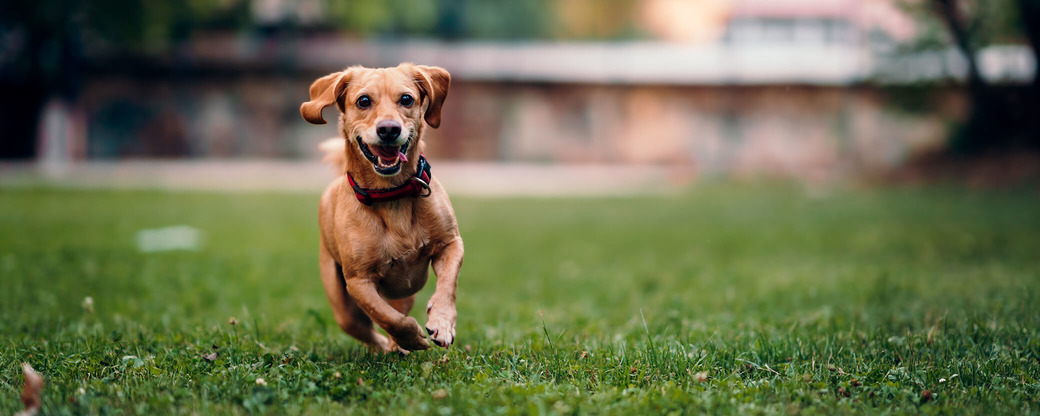Many four-legged friends love physical exercise. However, it is the responsibility of their owners to individually recognise what amount and type of exercise will keep our dogs happy and healthy. In addition to exercise, the right diet and nutrient balance is also an essential factor.
One often hears about developmental disorders of the skeleton a nd joint diseases, especially in large dog breeds, but smaller breeds are also affected.
Such diseases can be hereditary, but are often promoted by errors in diet and by incorrect stresses. This can lead to changes in the joint cartilage, which promotes arthrosis or arthritis.
As a protective layer, the cartilage tissue covers the joint surface and is very important for pain-free and optimal movement. A sufficiently thick layer of cartilage must be present in order to adequately absorb shocks and other loads during movement sequences. In addition, sufficient water must be stored in the cartilage so that the tissue remains elastic and resistant. In addition, it is necessary for the cells of the joint capsule to form sufficient synovial fluid for healthy, smooth movement.
Osteoarthritis is a chronic joint disease in which the joint cartilage is broken down. Arthritis, on the other hand, is an inflammation of the joints that usually occurs in episodes. However, arthritis can also lead to episodes of inflammation in the joint.
Symptoms
Especially with older dogs, the following behaviour is often seen: The dog can only get up from the dog bed with difficulty and stiffness after longer periods of lying down. It is difficult to get up and there are often start-up difficulties when moving from rest phases. Often, slight improvements seem to occur when the dog slowly starts to move and "runs in". However, depending on the joint, lameness may be noticeable and the dog may appear to be in pain dring certain movements. Usually the dog is reluctant to climb stairs, jump into the car, lie down abruptly, etc. and prefers warm places to sleep. In addition to these siens, affected joints may also be overheated and swollen due to inflammation. These indications lead to the suspicion that the animal is suffering from arthrosis as a chronic degenerative joint disease.
But not only older dogs are affected by these symptoms, so they cannot be attributed to increasing age alone. They can also be caused by joint deformities in young dogs, for example.
Osteoarthritis most commonly affects the elbow, shoulder, hip and knee. However, it can also occur in the spine and lower limb joints.
Diagnosis of osteoarthritis
Osteoarthritis usually develops slowly. Initial changes usually occur without visible symptoms. Later, lameness is accompanied by reduced joint mobility and increasing pain in the affected joint. The dog inevitably moves less as a result. This in turn leads to a decrease in musculature and tension, which causes further pain - a vicious circle develops.
If persistent or recurrent lameness is evident, if individual joints look swollen in comparison to each other, if they feel unusually warm or if they visibly cause the dog pain, a visit to the vet is necessary.
If arthrosis is suspected, other procedures are used to make a diagnosis in addition to a thorough examination. X-ray examinations play an important role in this. The severity of the disease can also be partially assessed with the help of an ultrasound examination and the condition of the cartilage and ligaments in the joint can be examined. In advanced arthrosis, changes in the cartilage, bones and ligaments become visible and the joint capsule hardens.
In the case of a swollen joint, a puncture can also be performed. In this case, joint fluid is taken from the joint with a hollow needle under strict hygiene measures and examined for e.g inflammatory cells.
Another examination option is an arthroscopy of the joint. This is a minimally invasive method of making a diagnosis directly on the diseased joint. Depending on the findings, treatment can also be carried out immediately during the same procedure. Due to the minimally invasive procedure, arthroscopy causes only minor injuries to the skin and soft tissues, which significantly reduces wound healing problems and the risk of infection. The advantage over other diagnostic examination options is the direct examination of the joint cartilage and the joint lining. An enlarged image of the structures in the joint makes even subtle injuries (lesions) visible and thus allows early diagnosis and treatment.
Treatment of osteoarthritis
Treatment of osteoarthritis is mainly carried out with the aim of relieving pain, restoring mobility and supporting joint functions such as supplying the cartilage and producing synovial fluid.
Conservative therapy methods are used to try to influence the disease without surgical intervention.
Possible excess weight should be reduced, as too much body weight puts strain on the joints. Regular, gentle movements and massages promote blood circulation, strengthen the supporting muscles and relieve tension. Movement promotes the production of joint fluid. The sleeping place should be warm and as comfortable as possible, made of soft materials. If necessary, painkillers can also be beneficial.
In particular, supplementary feeds with high doses of ingredients such as omega-3 fatty acids, vitamin E, green-lipped mussel, chondroitin, devil's claw and collagen Il can be given as a support in case of illness, but also as a preventive measure.
If the arthrosis is far advanced and non-surgical methods do not produce the desired treatment success, there are various surgical options. Joint fusion usually provides freedom from pain, but restricts the dog's mobility. Partial removal of a bone is sometimes possible and can preserve freedom of movement as the joint is supported by surrounding muscles. Artificial joints are also available for dogs, e.g. for the hip, elbow and knee joint.
However, surgery should always be the last resort in osteoarthritis therapy when all other treatment options have been exhausted.

